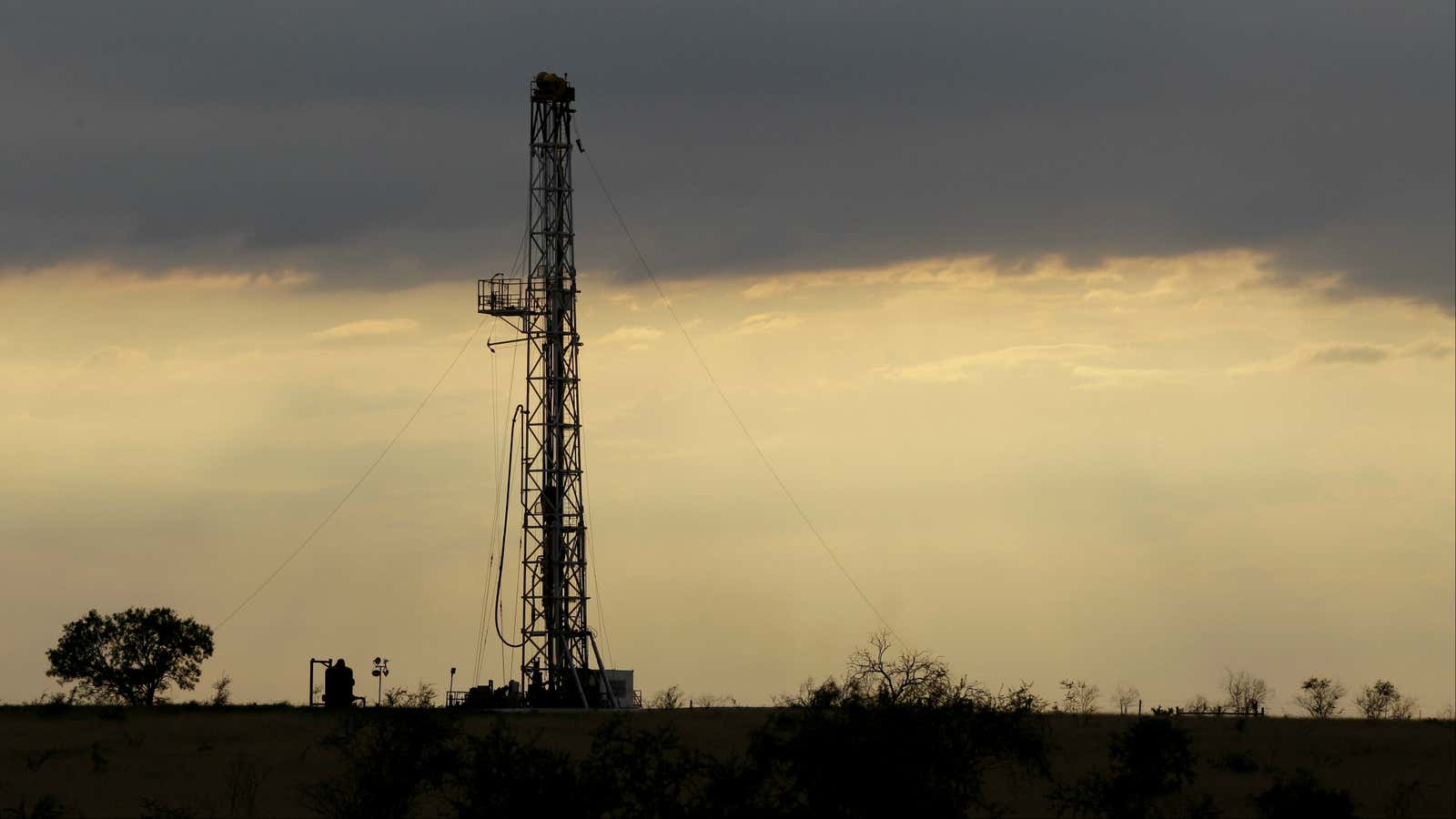OPEC is once again at odds with the market. This time, it’s not about the cartel’s strategy to dominate the oil trade. Instead, OPEC is in a debate with industry analysts and traders who are declaring the cartel the winner in a months-long war with US shale oil.
In a draft long-term strategy paper obtained by Reuters, OPEC—ahead of its June 5 gathering in Vienna—concludes that its days of misery will last for quite a while longer. Shale oil, a much hardier enemy than OPEC had once presumed, will keep oil prices relatively low for another two years and perhaps longer, the cartel says.
If OPEC is right—and by extension, traders are wrong—look for the pressure to increase on the countries that rely on oil exports to support their government spending. Russia’s Vladimir Putin, for example, has maintained his game face throughout the period of low oil prices and Western economic sanctions. It’s an emotionless expression that may be rooted in confidence that sooner or later, the West will relent on its financial penalties and the oil price will go back up.
But in Russia, as well as OPEC nations like Iran and Venezuela, another two years of low prices could be a difficult blow to absorb.
OPEC’s misery is about a year old
The story begins last June, when a surge of US shale oil production began to overshadow various geopolitical crises (in Iraq, Libya, and Nigeria, among others) that conspired to push prices above $115 a barrel. The shale produced a global oil glut, and prices began to plunge.
Then, in a surprising move that startled the market, OPEC, prodded by Saudi Arabia, decided in November not to take its usual course of action and cut production to try to halt the price slide. Instead, the cartel opted to hang on and let low prices “sweat” high-cost US shale producers out of the business. By early this year, the global oil surplus had gathered pace, and pushed down prices to about $45 a barrel.
OPEC appeared to achieve the result it sought—shale drillers began to idle rigs working US fields, and oil prices rebounded by about 30% from their lows, with Brent yesterday alone rising about 1% to $62.58 a barrel, and continuing up to $63.21 in early European trading today.
But in a report yesterday, the US Energy Information Administration said that US oil production surged last week to 9.56 million barrels a day, up from about 9.2 million the prior week. It was the highest US production in 44 years and, while subject to potential revision, suggested at a minimum that low prices have not curtailed shale.
Despite all that, oil prices are rising anyway because hopeful traders latched onto other details in the report—namely that crude oil inventories dropped by an unexpectedly high amount (by 2.8 million barrels rather than the 857,000 barrels forecast by analysts). Traders apparently clung onto this supply draw as a signal of higher oil demand and a tightening market.
Earth to bullish analysts
For purposes of clarity, perhaps these analysts should return to OPEC’s strategic rationale, which is not to reduce US inventories, but to stop US shale production in its tracks. By that measure, it is failing.
It’s true that the number of oil rigs drilling on the US patch has fallen for 24 straight weeks, plunging by 59% from their peak last October. But, in a May 22 note to clients, Goldman Sachs noted that only one rig stopped work last week, and that the number of ultra-crucial horizontal rigs—those that make shale drilling work—rose by four.
In other words, at this stage, the shale bloodbath is either over or close to it. Goldman forecasts that, despite OPEC’s tough-minded action, determined US shale oil production will rise by 170,000 barrels a day this year, and by 225,000 barrels in 2016. (For more clarity yet, watch this video, a Bloomberg interview with Oppenheimer’s Alessio De Longis.)
In fact, OPEC outliers are actively contributing to the glut. Iraq has embarked on an unexpected surge of new supply—its exports seem likely to rise from 3 million barrels a day to 3.75 million as soon as next month.
So much oil is sloshing around the world that the daily leasing rate for supertankers is up 24% since May 6, to about $65,700 a day, the highest since 2008.
It will get worse in the event that a nuclear deal is signed in the coming weeks with Iran—a strong possibility. If a deal happens, look for yet another million barrels a day of oil over the subsequent year or so.
A collective shrug
OPEC has come around to the view that, almost regardless of what it does, shale oil is a fact of life, according to the report obtained by Reuters. Notwithstanding low prices, even high-cost shale producers will keep pumping oil in order to finance at least part of their operating costs, the report says. Under the assumption that prices will eventually recover, shale drillers will also continue to drill new wells.
Four years from now, OPEC says it will be producing just 28.7 million barrels a day, less than it currently does. Yet, all is not lost. By 2040, the report says, demand for OPEC crude will have spiked back up and reached about 40 million barrels a day. But for OPEC, the real battle is how to get there in one piece.
